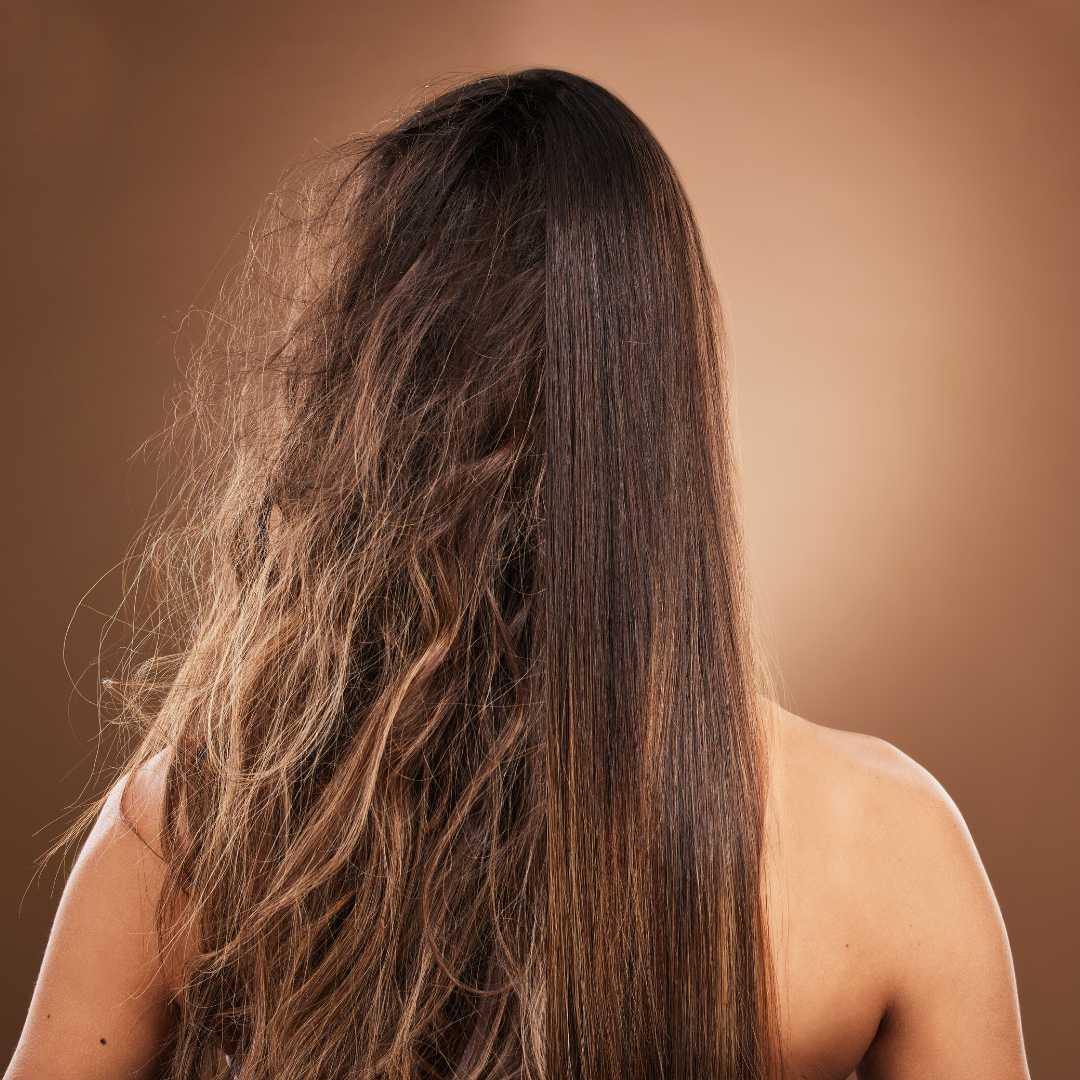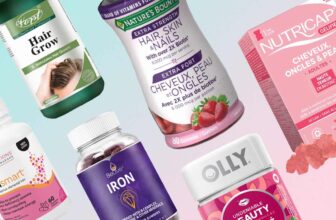
[adinserter block=”1″]
Let’s talk about how to repair damaged hair!
Hair is much more than just fibrous strands atop our heads. It’s a crown of confidence, an emblem of self-expression, and a key part of our self-identity.
However, it’s also vulnerable to damage from various factors, such as heat, chemicals, pollutants, and even our own daily habits.
The good news is that hair damage isn’t a life sentence; with the right TLC, your locks can regain their former glory. Here are ten expert tips for repairing your hair from the inside out.
💡TIP: Pin this article to your Hair Care board on Pinterest so you can always come back when you need to! 👇🏼👇🏼👇🏼

What is Damaged Hair?

Damaged hair is weakened or harmed in some way. It can happen for various reasons, such as excessive heat styling, harsh chemical treatments, or even environmental factors like sun exposure and pollution.
Damaged hair and healthy hair differ in several key aspects. Healthy hair is typically soft, smooth, and shiny, with a strong structure and minimal breakage. It has a natural elasticity and can withstand normal styling and environmental factors without becoming excessively dry or brittle.
On the other hand, damaged hair often appears dull, rough, and frizzy. It may have split ends, break easily, and feel dry or straw-like. Damaged hair lacks the resilience and vitality of healthy hair and may require special care and attention to restore its health and appearance.
#1. Regular Trims

Regular hair trims are the best way to fix damaged hair. Trimming off the split ends keeps your hair looking healthy and prevents the damage from spreading up the hair shaft. It also helps your hair grow stronger and smoother.
Plus, removing damaged ends can make your hair easier to style and manage. So, even though it might seem small, getting regular trims can make a big difference in keeping your hair looking and feeling its best!
#2. Deep Conditioning

Using a deep conditioner or hair mask is necessary to repair damaged hair. These masks are like super-powered treatments that penetrate deeply into the hair shaft, providing intense hydration and nourishment.
It will help strengthen and repair damaged strands, making your hair softer, smoother, and more resilient. Furthermore, deep conditioning treatments help seal the hair cuticle, reducing frizz and enhancing shine.
Including a weekly deep conditioning treatment in your hair care routine can significantly improve your hair’s health and appearance, leaving it revitalized and refreshed.
#3. Protein Treatments

Likewise, protein treatments are a great way to fix hair breakage! They help rebuild the structure of your hair, filling in any gaps and making it stronger and more resilient (learn more about Olaplex, one of my favorites).
They can also help reduce breakage and split ends, leaving your hair looking healthier and more vibrant. If your hair feels weak or brittle, incorporating a protein treatment into your routine can give it the extra boost it needs to return to life.
#4. Limit Heat Styling

Excessive heat from tools like straighteners, curling irons, and blow dryers can strip moisture from the hair, leaving it dry, brittle, and prone to breakage. Reducing heat styling gives your hair a chance to recover and regain its natural strength and resilience.
Consider air-drying and always use a heat protectant when using hot tools. Remember, less thermal damage means healthier hair, so give your hair a break and watch it flourish!
#5. Handle With Care

Being rough with your hair, like brushing too vigorously or tying it up tightly, can cause more damage and breakage. Here are a few tips to help prevent future damage:
- Use a wide-tooth comb: Start by gently detangling your hair using a wide-tooth comb. This helps prevent breakage and minimize stress on the hair strands.
- Be gentle with wet hair: Wet hair is more prone to breakage, so handle it with care. Avoid rough towel-drying; gently squeeze out excess water with a soft microfiber towel or a cotton t-shirt.
- Be mindful when brushing: Use a brush with soft bristles and brush your hair gently, starting from the ends of your hair. Avoid brushing fragile hair too vigorously, especially when your hair is tangled.
- Avoid pulling or tugging: Be gentle when handling your hair, avoiding pulling or tugging on knots or when styling. Use gentle hair ties without metal clasps, and avoid tight hairstyles that can cause stress on the hair shaft.
- Protect hair while sleeping: Use a silk or satin pillowcase to reduce friction on your hair while you sleep. Try braiding your hair loosely or using a silk scarf or bonnet to protect it from tangling and breakage.
- Choose gentle hair care products: Use mild shampoos and conditioners suitable for your hair type, avoiding harsh chemicals that can strip moisture and weaken hair.
- Avoid hot water: Hot water can strip the hair of its natural oils, leaving it dry and brittle. Wash your hair with lukewarm or cool water instead to help maintain its moisture and prevent damage.
Implementing these gentle hair handling tips into your hair care routine can help prevent damage and keep your locks looking healthy and vibrant.
#6. Reduce Chemical Processing

Reducing chemical processing is vital when trying to repair damaged hair.
Chemical treatments like coloring, bleaching, and perming can weaken the hair structure and lead to breakage and dryness. Minimizing these processes allows your hair to recover and rebuild its strength.
Choosing gentler, ammonia-free dyes or opting for natural hair colors can help prevent further damage. For best results, try spacing out chemical treatments. Remember, the lived-in look is super trendy right now, so take advantage of it.
#7. Protective Styles

We often think of protective styles as a way to take a break from daily styling, but they also protect our hair from environmental damage. Styles like braids, twists, and buns tuck the ends of the hair away, reducing the amount of exposure to elements that can cause dryness and breakage.
Just be sure not to make these styles too tight, as they can lead to traction alopecia, a specific type of damage.
#8. Scalp Care

Taking care of your scalp is essential when you’re trying to repair damaged hair. A healthy scalp provides the foundation for strong, beautiful hair growth.
When the scalp is dry, irritated, or clogged with product buildup, it can hinder hair growth and contribute to further damage. Gentle scalp massages can stimulate blood flow and promote hair growth, while regular cleansing with mild shampoo can keep the scalp clean and free from excess oil and debris.
Remember, a happy scalp leads to healthier hair, so remember to give it the attention it deserves!
#9. Eat a Balanced Diet

Just like our bodies, hair needs essential nutrients to stay healthy and strong. Foods rich in vitamins, minerals, and proteins, such as fruits, vegetables, lean proteins, and whole grains, provide the building blocks for healthy hair growth. Nutrients like vitamin E, biotin, and omega-3 fatty acids are particularly beneficial for hair health.
By nourishing your body with a balanced diet, you’re giving your hair the fuel to repair and thrive, leaving you with shiny, vibrant locks.
#10. Stay Hydrated

Hydration is essential for overall health, and hair is no exception. Dehydration can lead to dry, dull, and brittle hair. Drinking plenty of water is the most direct way to combat this, ensuring that your body and hair are adequately hydrated from the inside out.
Consider a water bottle with time markers to help you keep track of your intake throughout the day.
Final Thoughts

Repairing damaged hair is not an overnight fix; it requires patience and a commitment to healthy practices.
Understanding the causes of damage and implementing effective strategies, such as regular trims, deep conditioning treatments, and gentle handling, can revitalize your hair and restore its natural strength and shine. Remember to nourish your hair from the inside out by maintaining a balanced diet, staying hydrated, and caring for your scalp.
With patience, consistency, and the right approach, you can say goodbye to damaged hair and hello to vibrant and resilient hair that’s full of life.
Until next time,


MEET THE AUTHOR 🤩
Hollee is a licensed cosmetologist with over nine years of professional experience in the hair industry. With her unique insight and versatile experience, she’ll help you discover the latest hair trends or even crush your next DIY hair project.
🌟 Your Turn: What did you think about these tips to repair hair damage? Is there anything else I should add to this list? Drop your thoughts in the comments section below! 👇🏼👇🏼👇🏼
🥰 Other Posts You’ll Like:
[adinserter block=”1″]
Source link







